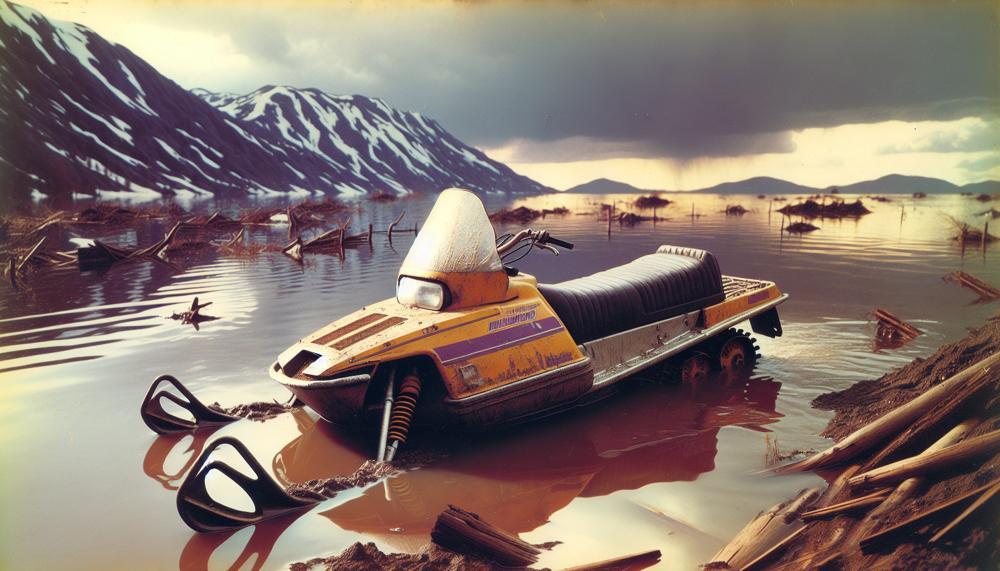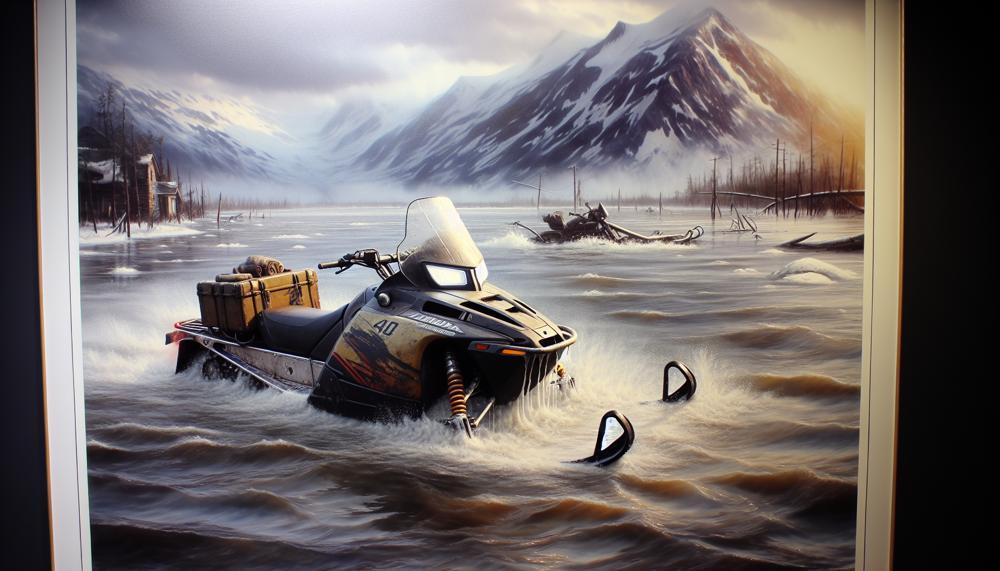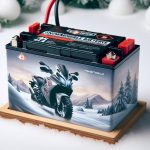Imagine this: it’s a crisp winter day and you’re ready to hit the snowy trails on your trusty snowmobile. But as you approach your machine, you notice something concerning – it’s completely flooded.
Before you start to panic, know that starting a flooded snowmobile is not as intimidating as it may seem. With a few simple steps and some useful tips, you’ll be back on the snow in no time.
So, how do you start a flooded snowmobile?
A snowmobile can flood if it’s over-primed or over-choked. Here are some things you can try:
- Wait:Let any extra fuel evaporate for about 20 minutes before restarting.
- Dry the spark plugs: Remove the spark plug and dry it of gasoline. You can also try pulling the plugs out about ten times, then forcing extra fuel out with your breath.
- Wire brush the spark plug: Wire brush the end of the spark plug off and hold a lighter on it for about 30 seconds.
- Turn off the choke: With the choke off, more air can go through the carburetor to the engine. This helps the engine burn off the excess fuel.
- Hold the throttle open: With the choke off, hold the throttle wide open and pull it over until it starts.
- Crank over the engine: With the spark plug removed, crank over the engine for 30 seconds to blow out and dry the cylinder. Then, reinstall the spark plug.
- Fire it up: Put the plug back in and fire it up without using any choke. If it doesn’t catch, hold the throttle quarter-half open and pull.
A flooded engine usually makes a loud high-pitched whirring sound.
Whether you’re new to the world of snowmobiling or an experienced rider, keep reading to learn how to tackle this frustrating situation with confidence. Let’s get your engine roaring again.
How do You Start a Snowmobile with an Electric Start?
Contents
- 1 How do You Start a Snowmobile with an Electric Start?
- 2 How do you Pull Start a Snowmobile?
- 3 How do You Make a Pull Start Easier on a Snowmobile?
- 4 How do You Start a 2-Stroke Snowmobile?
- 5 How do You Start a Snowmobile with an Empty Battery?
- 6 How do You Start a Snowmobile Without a Pull Cord?
- 7 How to Start a Flooded Snowmobile
- 8 How do You Start Snowmobile After it’s Been Sitting?
- 9 Conclusion
Starting a flooded snowmobile can be a bit more challenging. It involves troubleshooting and additional steps to clear out excess fuel from the engine.
The first step is identifying the cause of flooding, which can be due to various reasons such as a clogged carburetor or a malfunctioning choke.
Once the cause is determined, excess fuel must be removed from the engine by draining it or using a vacuum pump. Next, check and clean the spark plugs, as they may have become fouled with too much fuel.
After that, dry out the engine by removing the spark plugs and cranking the engine to get rid of any remaining fuel. If necessary, use a starting fluid to jumpstart the ignition.
It is crucial to regularly maintain your snowmobile to prevent flooding and ensure smooth operation. This includes checking and cleaning the carburetor and spark plugs, ensuring proper fuel levels, and addressing any issues that may arise.
How do you Pull Start a Snowmobile?
When attempting to pull-start a flooded snowmobile, it’s important to take extra care and attention to avoid damaging the vehicle.
The following are the steps you should follow to properly pull start a flooded snowmobile:
- Check for any obstructions: Before attempting to pull start your flooded snowmobile, make sure there aren’t any blockages in the exhaust or throttle. This is crucial in ensuring your vehicle starts smoothly.
- Clear out excess fuel: One of the main reasons for a flooded snowmobile is an abundance of fuel in the engine. To get rid of this, remove the spark plugs and pull the cord multiple times to eliminate any excess fuel.
- Dry out the spark plugs: If your spark plugs are damp from excess fuel, you’ll need to dry them before trying to start the vehicle again. Use a cloth or paper towel to wipe away any extra fuel on the plugs.
- Pull with care: When attempting to pull-start a flooded snowmobile, be cautious and pull slowly at first. This will help prevent any harm to the engine or starter system.
- Use a larger pulley: As mentioned earlier, using a bigger pulley can make pull-starting easier. Consider replacing your current pulley with a larger one for smoother starts.
- Regularly maintain your snowmobile: To avoid future flooding, it’s essential to keep your snowmobile well-maintained. This includes checking for any leaks or issues with the fuel and electrical systems.
How do You Make a Pull Start Easier on a Snowmobile?
Pull starting a snow machine can be a daunting task, especially in freezing weather conditions. But don’t worry, there are various techniques and strategies that you can use to make this process smoother and more efficient.
- Use premium synthetic oil: One of the main reasons for the difficulty in pull starting a snowmobile is due to the thickening of oil in cold temperatures. To combat this, it is essential to use top-quality synthetic oil that can withstand low temperatures. This will help the engine to turn over easily and start.
- Warm up the engine: Before attempting to pull start your snowmobile, it is crucial to warm up the engine first. You can do this by turning on the engine for a few minutes or using an electric starter if available. This will aid in oil circulation and allow the engine to reach an optimal temperature for starting.
- Regular maintenance: Properly maintaining your snowmobile can also make pull starting easier. This includes checking for any clogs or damages in spark plugs, fuel lines, and air filters. Keeping these components in good condition will ensure that your snowmobile starts smoothly.
- Use the right grip and technique: When pulling the cord, it is vital to use the correct grip and technique. Hold the handle firmly and pull with a quick, fluid motion. Avoid pulling too hard or jerking the cord, as it can cause injury or damage to your snowmobile.
- Consider using an electric starter or hand warmer: In extremely cold conditions, using an electric starter or hand warmer can make pull starting much easier. These devices will help warm up the engine and make it easier to start.
- Prioritize safety: It is crucial to always prioritize safety when working with a snowmobile, especially in cold weather conditions. This includes wearing protective gear like gloves and goggles and abstaining from alcohol consumption.
| Techniques | Strategies |
|---|---|
| Use premium synthetic oil | Warm up the engine before attempting to pull start |
| Regularly maintain your snowmobile | Use the right grip and technique while pulling the cord |
| In extreme cold conditions, consider using an electric starter or hand warmer | Prioritize safety at all times |

By following these techniques and strategies, you can make pull starting your snowmobile a breeze, even in the most frigid weather conditions.
How do You Start a 2-Stroke Snowmobile?
If your 2-stroke snowmobile has been flooded, do not worry. Follow these steps to get it started and back on the snow:
- Check the Spark Plugs: The first step is to check the spark plugs. If they are drenched or dirty, clean them or replace them if needed.
- Dry the Engine: Use a cloth or paper towel to wipe off any excess fuel in the engine. This will help prevent further flooding.
- Clear the Carburetor: If there is an excessive amount of fuel reaching the carburetor, it can cause flooding. Remove the air filter and spray some starting fluid into the carburetor to help clear any extra fuel.
- Warm Up the Engine: Before trying to start the snowmobile, make sure the engine is warm. This will help evaporate any remaining fuel and make it easier to start.
- Start with Half Throttle: When starting a flooded snowmobile, try using half throttle instead of full throttle. This will help prevent flooding again and give the engine a better chance of starting.
- Utilize Electric Starters or Hand Warmers: If you are having trouble pulling the starter cord, try using an electric starter or hand warmers to warm up your hands and make pulling easier.
- Prioritize Safety: Always prioritize safety when starting a snowmobile. Make sure the area is free of obstacles and people, and wear appropriate gear such as helmets and goggles.
| Step | Description |
| 1 | Examine Spark Plugs |
| 2 | Dry Engine Thoroughly |
| 3 | Clear Carburetor Blockage |
| 4 | Warm Up Engine |
| 5 | Use Half Throttle |
| 6 | Utilize Electric Starters or Hand Warmers |
| 7 | Prioritize Safety Measures |
By following these steps and prioritizing regular maintenance, you can avoid flooding issues and ensure your snowmobile starts smoothly every time.
It is important to regularly check and maintain your snowmobile to prevent any unexpected issues on the snow.
Just like a car, it requires regular maintenance and care to prolong its lifespan. In fact, I remember one time when I was out on the snow with my friends, my snowmobile suddenly stopped working.
After checking the spark plugs, I realized they were drenched due to the heavy snowfall.
How do You Start a Snowmobile with an Empty Battery?
There are several steps you can take to start a snowmobile with an empty battery. Whether you need to jumpstart your snowmobile or use alternative methods, it is important to follow proper safety protocols and replace the battery as soon as possible.
Here are the steps you can follow to get your snowmobile back on the road:
- Prepare necessary materials: To jumpstart a snowmobile, you will require jumper cables and a working 12-volt battery. Alternatively, if your snowmobile does not have a battery, you can use a jump box or pull-start it.
- Connect the cables: Attach the red or positive clamps to the positive terminals on both batteries, and the negative clamp to the negative terminal on the functional battery. The unused end of the negative cable must be grounded.
- Exercise caution: Avoid letting the connected cable clamps touch each other or any other objects, as this can cause sparks and explosions. Make sure to properly identify the positive and negative terminals on both batteries and cables before connecting them.
- Turn off other vehicles: Ensure that all other vehicles are turned off while jumpstarting and refrain from touching the metal clamps with your hands for safety reasons.
- Replace the battery: It is crucial to replace the battery as soon as possible to prevent any electrical issues.
By following these steps, you should be able to get your snowmobile up and running again in no time. However, it is always recommended to properly maintain your snowmobile’s battery to avoid any unexpected issues on the snowy terrain.
How do You Start a Snowmobile Without a Pull Cord?
Starting a snowmobile without a pull cord can seem daunting, but there are several alternative methods available. These include electric starters, jump-starting, compression starting, push-starting, warming up the engine, using carburetor cleaner or starting fluid, kick-starting, and seeking professional help.
These methods can be used in the event that the pull cord is missing or broken. However, it is always best to have a reliable pull cord as the primary starting method. Let’s take a closer look at each alternative method:
- Electric starter: For modern snowmobiles, an electric starter is the most convenient option. Simply locate the starter button or switch on the handlebars and engage the electric starter motor.
- Jump-starting: If your snowmobile does not have an electric starter, you can try jump-starting it using a power source such as a vehicle with a working battery and jumper cables.
- Compression starting: This method harnesses the mechanical power of the engine. To use it, activate the compression release lever or valve, apply gentle force to rotate the engine, and then disengage the compression release once the engine starts running.
- Push-starting: Similar to push-starting a car, this method requires two to three people. One person sits on the snowmobile while someone else pushes it at a speed of 10 to 15 MPH before quickly engaging the throttle lever.
- Warming up the engine: In cold weather, it’s important to warm up your snowmobile’s engine before starting it. You can do this in a sheltered area or by using a block heater or heat gun.
- Using carburetor cleaner or starting fluid: If your snowmobile won’t start after being warmed up, try spraying carburetor cleaner or starting fluid into the air intake.
- Kick-starting: For older snowmobiles, there may be a kick-starting option. This involves pulling down on a kick-starter lever near the engine until it starts running.
- Seeking professional help: If all else fails, it’s best to seek assistance from a professional snowmobile mechanic.
How to Start a Flooded Snowmobile
Follow these steps to safely start a flooded snowmobile:
- First, make sure to turn off the engine and remove the key from the ignition. This is important to prevent any accidental starting.
- Locate the spark plugs on the engine and remove them. This will allow any excess fuel to evaporate from the cylinders.
- Take a close look at the spark plugs and check for any signs of fouling or damage. If necessary, clean or replace them before moving on.
- After removing the spark plugs, let them dry for a few minutes before putting them back in the engine.
- Now, turn off the fuel supply valve and drain any excess fuel from the engine. This will help prevent further flooding.
- Allow the engine to dry for a few minutes before attempting to start it again.
- Before turning on the ignition, take necessary precautions such as clearing the area of any flammable materials and ensuring that the snowmobile is on a flat surface.
- Once you are ready, turn on the ignition and give small throttle bursts to clear any remaining fuel from the engine.
- If needed, you can use starting fluid or carburetor cleaner to help ignite the fuel.
- Try starting the snowmobile again, and if it still does not start, repeat the process of removing excess fuel and trying again.
- If none of these steps work, it is best to take your snowmobile to a professional mechanic for further maintenance and repairs.
How do You Start Snowmobile After it’s Been Sitting?
If your snowmobile has been sitting for a prolonged period, there are several steps you can take to ensure it starts up smoothly. Follow these steps to start your snowmobile after it has been sitting:
- Inspect the spark plugs: The first thing you should do is inspect the spark plugs. Over time, they can become fouled or damaged, which can prevent the engine from starting. Remove the spark plugs and check for any signs of wear or damage. If they appear worn or dirty, it’s best to replace them.
- Test the spark plugs: If the spark plugs seem to be in good condition, you can test them to ensure they are functioning properly. This is a straightforward process that involves removing the spark plugs and reconnecting them to the ignition wires. While holding the spark plug against a metal surface, have someone attempt to start the engine. If a strong, blue spark is visible, then the spark plugs are functioning correctly. If there is no spark or it is weak, then the spark plugs need to be replaced.
- Check for electrical issues: If replacing the spark plugs does not solve the issue, there may be an underlying electrical problem preventing your snowmobile from starting. This could be due to a faulty ignition switch or wiring issue. In this case, it’s best to seek professional help to diagnose and fix the problem.
- Address fuel issues: Another common cause of starting problems is a lack of fuel. If your snowmobile hasn’t been used in a while, there may be stale or old fuel in the tank, which can prevent the engine from starting. You can try using starting fluid to get the engine going or clean the carburetor to remove any buildup.
- Check compression: Low compression in the cylinders can also prevent your snowmobile from starting. This is a more serious issue that may require professional servicing.
- Run the engine regularly during off-season: To avoid starting issues in the future, it’s recommended to run the engine at least once a week during the off-season. This will help keep the engine and components in good working condition.
Conclusion
In conclusion, starting a flooded snowmobile may seem like a daunting task, but fear not.
With the right knowledge and techniques, you can easily overcome this challenge. By understanding the common causes of flooding and following a step-by-step process for starting a flooded engine, you’ll be back on the snowy trails in no time.
And don’t forget to implement expert advice for prevention and troubleshooting to avoid future flooding issues. Whether it’s using an electric start or carefully pull-starting, regular maintenance is crucial for keeping your snowmobile in top shape.
And in case of an empty battery, knowing how to properly jumpstart your snowmobile is essential for any unexpected situations.






